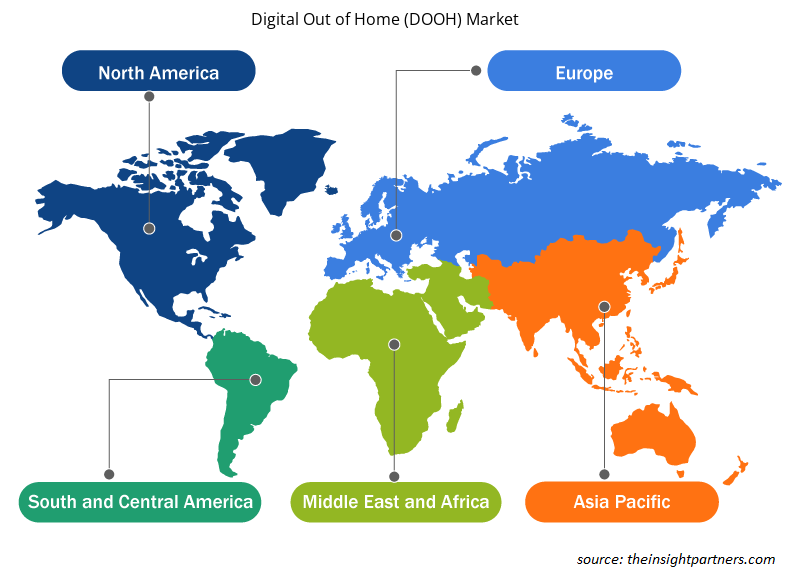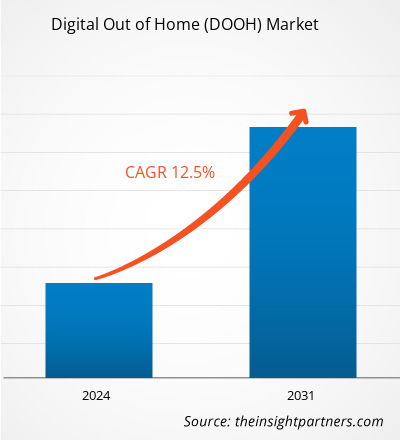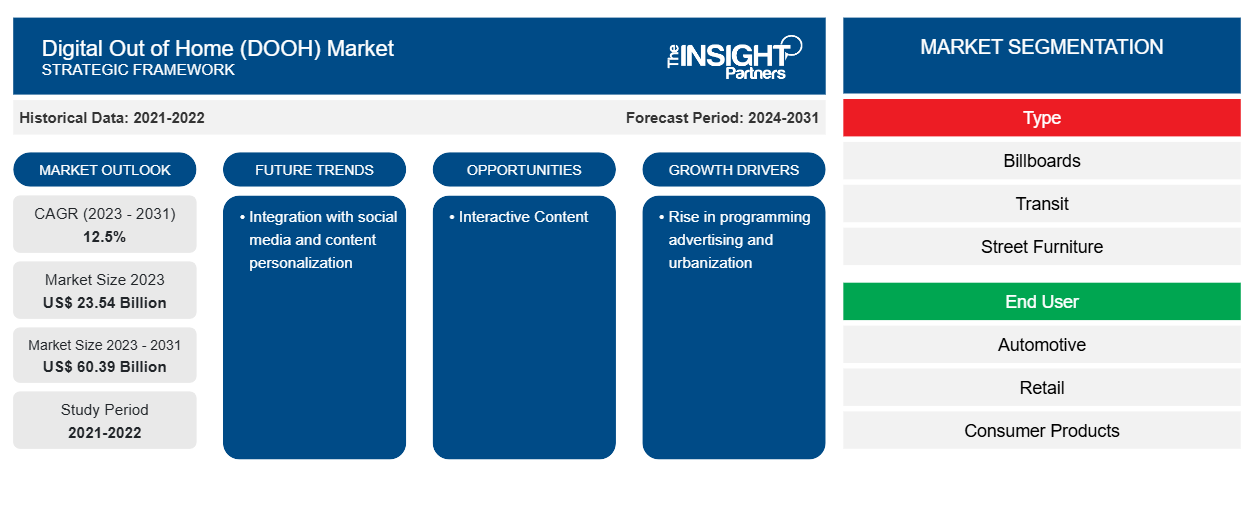Se proyecta que el tamaño del mercado de publicidad exterior digital (DOOH) alcance los 60.390 millones de dólares en 2031, frente a los 23.540 millones de dólares en 2023. Se espera que el mercado registre una CAGR del 12,5 % entre 2023 y 2031. Es probable que la integración con las redes sociales y el contenido interactivo sigan siendo tendencias clave del mercado de publicidad exterior digital (DOOH).
Análisis del mercado de publicidad digital exterior (DOOH)
La publicidad exterior digital (DOOH, por sus siglas en inglés) es un nuevo tipo de medio conocido como publicidad exterior o fuera del hogar (OOH, por sus siglas en inglés). A diferencia del marketing digital en línea y otros dispositivos, los medios DOOH se ven en vallas publicitarias, pantallas LED y señalización digital en lugares públicos de alto tráfico donde la gente ya pasa tiempo fuera de sus hogares. Permite a los especialistas en marketing conectarse sin esfuerzo con los consumidores mientras realizan sus vidas diarias, ofreciendo contenido contextualmente relevante a audiencias objetivo a gran escala.
Descripción general del mercado de publicidad digital en exteriores (DOOH)
La publicidad digital OOH se ha convertido en una plataforma cada vez más sólida y exitosa para que los especialistas en marketing se comuniquen con los consumidores del mundo real. El panorama de la publicidad digital OOH cambia constantemente a medida que avanza la tecnología y cambian los comportamientos de los consumidores. Uno de los principales beneficios de la publicidad digital OOH es la capacidad de recopilar datos y realizar un seguimiento de la eficacia de las campañas.
Personalice este informe según sus necesidades
Obtendrá personalización en cualquier informe, sin cargo, incluidas partes de este informe o análisis a nivel de país, paquete de datos de Excel, así como también grandes ofertas y descuentos para empresas emergentes y universidades.
-
Obtenga las principales tendencias clave del mercado de este informe.Esta muestra GRATUITA incluirá análisis de datos, desde tendencias del mercado hasta estimaciones y pronósticos.
Impulsores y oportunidades del mercado de publicidad exterior digital (DOOH)
Aumento de la publicidad programática para favorecer el mercado
La publicidad programática está transformando la forma en que se muestran los anuncios en línea y también está empezando a hacer lo mismo con los anuncios colocados en áreas públicas. En el futuro, la publicidad programática será aún más importante en estos entornos públicos. Permitirá a los anunciantes comprar y vender automáticamente espacios publicitarios en tiempo real. Esto les facilitará las cosas y les permitirá dirigirse a las personas adecuadas con sus anuncios en el momento adecuado. Mediante el uso de datos e información, los anunciantes podrán desarrollar publicidad dirigida que sea relevante para las personas que los vean. Esto dará como resultado anuncios más efectivos.
Contenido interactivo: una oportunidad en el mercado de la publicidad digital exterior (DOOH)
Los consumidores buscan cada vez más experiencias inmersivas que vayan más allá de la visualización pasiva. En respuesta a ello, la publicidad OOH incorpora aspectos interactivos para hacerla más atractiva. Las pantallas táctiles, la realidad aumentada (RA) y la realidad virtual (RV) se están incorporando a las pantallas digitales, lo que permite a los consumidores interactuar con el material y las empresas en tiempo real.VR) are being incorporated into digital displays, allowing consumers to engage with material and companies in real-time.
Análisis de segmentación del informe de mercado de publicidad digital en exteriores (DOOH)DOOH) Market Report Segmentation Analysis
Los segmentos clave que contribuyeron a la derivación del análisis del mercado digital fuera del hogar (DOOH) son el tipo y el usuario final.
- Según el tipo, el mercado de publicidad exterior digital (DOOH) se divide en vallas publicitarias, transporte público, mobiliario urbano y publicidad basada en el lugar. El segmento de vallas publicitarias tuvo la mayor participación del mercado en 2023.
- Según el usuario final, el mercado digital fuera del hogar (DOOH) se divide en automotriz, minorista, productos de consumo, BFSI, telecomunicaciones y otros.
Análisis de la cuota de mercado de publicidad digital exterior (DOOH) por geografía
El alcance geográfico del informe de mercado Digital Out of Home (DOOH) se divide principalmente en cinco regiones: América del Norte, Asia Pacífico, Europa, Medio Oriente y África, y América del Sur/América del Sur y Central.
América del Norte ha dominado elMercado de publicidad exterior digital (DOOH). La infraestructura tecnológica avanzada que respalda las pantallas de alta calidad está impulsando la demanda de mercados de publicidad exterior digital (DOOH) en la región.
Perspectivas regionales del mercado de publicidad digital en exteriores (DOOH)
Los analistas de Insight Partners explicaron en detalle las tendencias y los factores regionales que influyen en el mercado de publicidad exterior digital (DOOH) durante el período de pronóstico. Esta sección también analiza los segmentos y la geografía del mercado de publicidad exterior digital (DOOH) en América del Norte, Europa, Asia Pacífico, Oriente Medio y África, y América del Sur y Central.

- Obtenga datos regionales específicos para el mercado de publicidad digital fuera del hogar (DOOH)
Alcance del informe de mercado de publicidad digital exterior (DOOH)
| Atributo del informe | Detalles |
|---|---|
| Tamaño del mercado en 2023 | US$ 23,54 mil millones |
| Tamaño del mercado en 2031 | US$ 60.39 mil millones |
| CAGR global (2023 - 2031) | 12,5% |
| Datos históricos | 2021-2022 |
| Período de pronóstico | 2024-2031 |
| Segmentos cubiertos |
Por tipo
|
| Regiones y países cubiertos |
América del norte
|
| Líderes del mercado y perfiles de empresas clave |
|
Densidad de actores del mercado de publicidad exterior digital (DOOH): comprensión de su impacto en la dinámica empresarial
El mercado de publicidad exterior digital (DOOH) está creciendo rápidamente, impulsado por la creciente demanda de los usuarios finales debido a factores como la evolución de las preferencias de los consumidores, los avances tecnológicos y una mayor conciencia de los beneficios del producto. A medida que aumenta la demanda, las empresas amplían sus ofertas, innovan para satisfacer las necesidades de los consumidores y aprovechan las tendencias emergentes, lo que impulsa aún más el crecimiento del mercado.
La densidad de actores del mercado se refiere a la distribución de las empresas o firmas que operan dentro de un mercado o industria en particular. Indica cuántos competidores (actores del mercado) están presentes en un espacio de mercado determinado en relación con su tamaño o valor total de mercado.
Las principales empresas que operan en el mercado de publicidad digital exterior (DOOH) son:
- Canal transparente para exteriores, LLC
- Broadsign International, Inc
- Outfront Media Inc
- Samsung Electronics Co. Ltd
- Compañía de publicidad Lamar
- Corporación NEC
Descargo de responsabilidad : Las empresas enumeradas anteriormente no están clasificadas en ningún orden particular.

- Obtenga una descripción general de los principales actores clave del mercado de Digital Out of Home (DOOH)
Noticias y novedades del mercado de publicidad exterior digital (DOOH)
El mercado de publicidad exterior digital (DOOH) se evalúa mediante la recopilación de datos cualitativos y cuantitativos posteriores a la investigación primaria y secundaria, que incluye publicaciones corporativas importantes, datos de asociaciones y bases de datos. A continuación, se incluye una lista de los desarrollos en el mercado de publicidad exterior digital (DOOH) y las estrategias:
- Heritage Outdoor Media colaboró con Daktronics para crear una valla publicitaria digital SMD con una resolución de 8 milímetros en el edificio Bow Tie, en el 1530 de Broadway, en Times Square, Nueva York. Torkian Group también participó en el acuerdo como inquilino minorista del cartel, conocido como el cartel "New York, New York", que intenta revolucionar la experiencia DOOH de Times Square incorporando experiencias tecnológicas emergentes como la realidad aumentada y la interacción móvil. (Fuente: Daktronics, Inc, comunicado de prensa, 2022)
Informe sobre el mercado de publicidad digital en exteriores (DOOH) y resultados finales
El informe “Tamaño y pronóstico del mercado de publicidad exterior digital (DOOH) (2021-2031)” proporciona un análisis detallado del mercado que cubre las siguientes áreas:
- Tamaño del mercado y pronóstico a nivel global, regional y nacional para todos los segmentos clave del mercado cubiertos bajo el alcance
- Dinámica del mercado, como impulsores, restricciones y oportunidades clave
- Principales tendencias futuras
- Análisis detallado de las cinco fuerzas de Porter y PEST y FODA
- Análisis del mercado global y regional que cubre las tendencias clave del mercado, los principales actores, las regulaciones y los desarrollos recientes del mercado.
- Análisis del panorama de la industria y de la competencia que abarca la concentración del mercado, el análisis de mapas de calor, los actores destacados y los desarrollos recientes
- Perfiles detallados de empresas
- Análisis histórico (2 años), año base, pronóstico (7 años) con CAGR
- Análisis PEST y FODA
- Tamaño del mercado, valor/volumen: global, regional y nacional
- Industria y panorama competitivo
- Conjunto de datos de Excel
Informes recientes
Testimonios
Razón para comprar
- Toma de decisiones informada
- Comprensión de la dinámica del mercado
- Análisis competitivo
- Información sobre clientes
- Pronósticos del mercado
- Mitigación de riesgos
- Planificación estratégica
- Justificación de la inversión
- Identificación de mercados emergentes
- Mejora de las estrategias de marketing
- Impulso de la eficiencia operativa
- Alineación con las tendencias regulatorias























 Obtenga una muestra gratuita para - Mercado de publicidad exterior digital (DOOH)
Obtenga una muestra gratuita para - Mercado de publicidad exterior digital (DOOH)